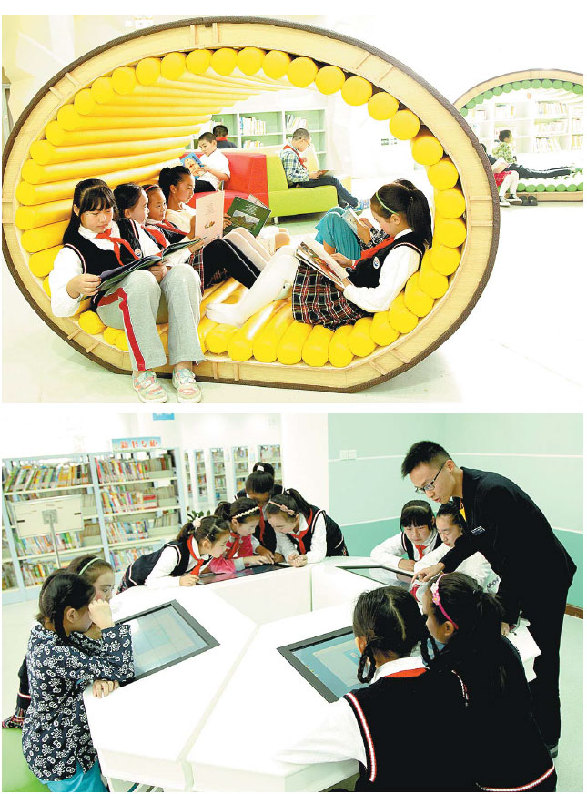Library a fun-tech place of learning

Zhangjiagang's children's library is a place where youngsters can literally snuggle up with padded-cloth books beneath giant mushrooms.
Or they can enjoy educational cartoons and games at hexagonal tables with touchscreens on the first floor, designed for kids under 3.
"The environment can help inspire their interest in reading," the library's director, Miu Jianxing, explained.
| Youngsters enjoy reading and learn to use touchscreens that enable them to write and store e-books in the children's library. |
"Three concepts animate our vision - offering different spaces and books for different ages; separating quiet reading corners from activity spaces; and enabling kids to read here or borrow books to take home."
He said adults' libraries usually sort books on the shelves according to categories such as literature, sci-fi and history.
But a children's library should consider their psychological development.
That's why there's a giant fake tree on the second floor, which is tailored for ages 3 to 5, and an abundance of comfortable and colorful seating.
"Young kids can't concentrate for long," Miu said.
"Activities engage them in reading."
The library partners with schools to stage such events as storytelling sessions for preschoolers and writing contests for older kids, deputy director Xu Menghua said.
It also helps schools establish their own libraries.
The third-floor reading room for middle-school students is a Confucian classroom replica replete with period furniture and faux brick walls. Many Chinese classics are among the hundreds of books.
Kids can not only read but also publish their own stories.
Tables set with touchscreens enable them to write and store e-books. They can return to the library after graduating from university to reread the books they wrote in their childhood, Xu said.
In the meantime, others can explore their works.
Kids can also make and store handmade paper books in the library.
Zhangjiagang's 12,000-square-meter kids library is the largest and most technologically advanced in county-level cities.
Many of the digital capacities were installed during a renovation earlier this year, Miu said.
The result has been an upsurge in visits, he explained.
Now, for instance, older children can scan their fingerprints, rather than use library cards, to access some facilities.
He recalled there were about 300 daily visitors to the city's adult and kids libraries combined when he started working there in 1985. There are more than 4,000 on average today, and around 10,000 during holidays.
Reading at the library is different from reading at school, he explained.
(China Daily European Weekly 10/22/2015 page11)
Today's Top News
- Japan tempting fate if it interferes in the situation of Taiwan Strait
- Stable trade ties benefit China, US
- Experts advocate increasing scope of BRI to include soft power sectors
- New engine powers cargo drone expansion
- China to boost green industry cooperation
- Manufacturing PMI rises in November































